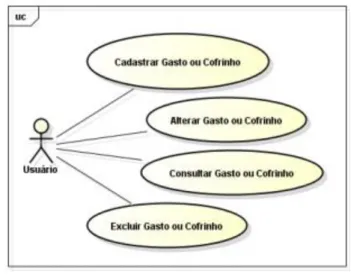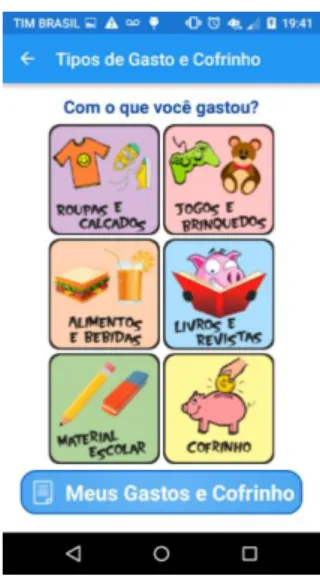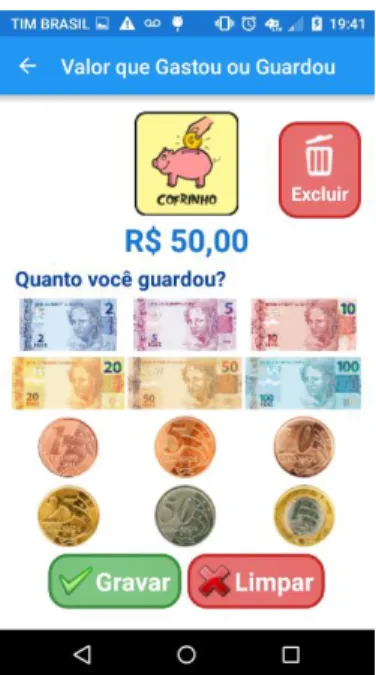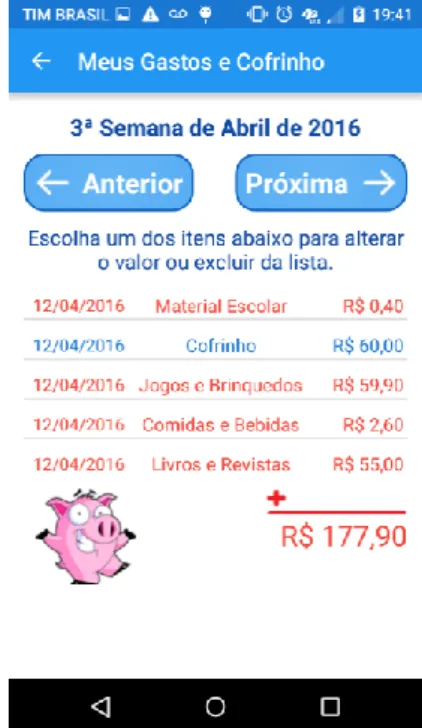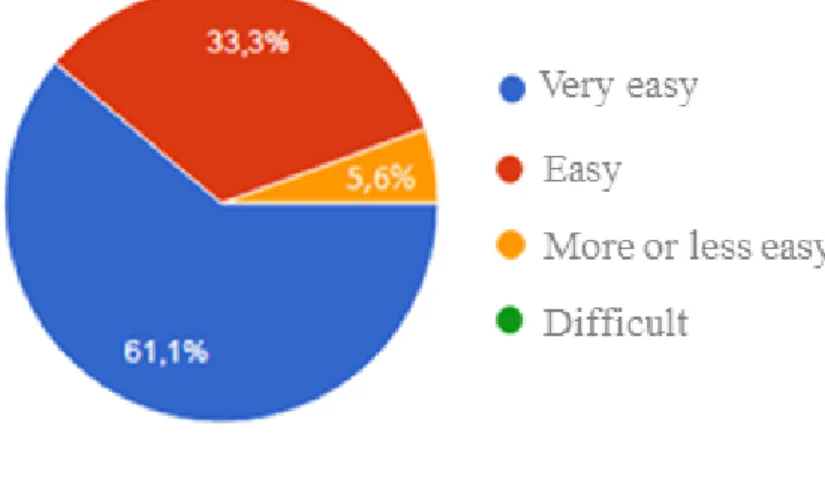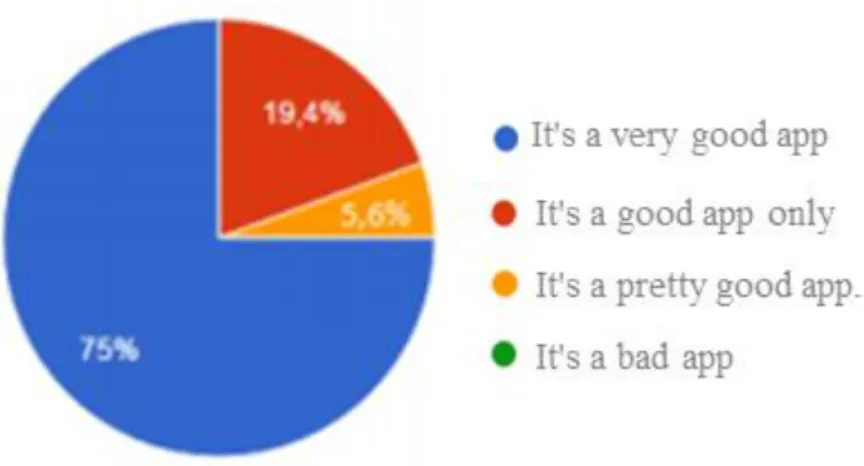NICO: APPLICATION TO ASSIST IN FINANCIAL EDUCATION TO
CHILDREN OF ELEMENTARY SCHOOL
NICO: APLICATIVO PARA AUXILIAR NA EDUCAÇÃO FINANCEIRA
DE CRIANÇAS DO ENSINO FUNDAMENTAL
Aldo Nascimento Pontes1
Maria das Graças Junqueira Machado Tomazela2 Danilo Cardoso Alves3
Article received in August, 2017 English version4
ABSTRACT
In a society where consumerism has become a benchmark for living well, and debt is an increasingly common condition, tools that help control personal spending are always welcome. Thus, the objective of this work is to present an application (Nico) for mobile devices developed to assist in the Financial Education of Elementary School children. The theoretical foundation brings some key concepts that support the study, anchored in research related to the theme (related works). The system was developed based on experimental research. It was later evaluated by 36 children from a public school in the city of Salto. The results showed that there was a positive and satisfactory return by the users, who evaluated the application and attributed a grade 9.0 to its functionalities.
Keywords: Contemporary childhood. Expense control. Mobile applications.
RESUMO
Em uma sociedade em que o consumismo se tornou referência de viver bem, e o endividamento uma condição cada vez mais comum, ferramentas que auxiliem no controle dos gastos pessoais são sempre bem-vindas. Assim, objetivo deste trabalho é apresentar aplicativo (Nico) para dispositivos móveis, desenvolvido para auxiliar na Educação Financeira de crianças do Ensino Fundamental. A fundamentação teórica traz alguns conceitos chave que sustentam o estudo, ancorados em pesquisas relacionadas ao tema (trabalhos relacionados). O sistema foi desenvolvido com base na pesquisa experimental. Posteriormente foi avaliado por 36 crianças de uma escola pública da cidade de Salto. Os resultados mostraram que houve um retorno positivo e satisfatório por parte dos usuários, que avaliaram a aplicação e atribuíram nota 9,0 às suas funcionalidades.
Palavras-chave: Infâncias contemporâneas. Controle de gastos. Aplicativos móveis.
1
Professor at the Faculty of Technology (Fatec) of Indaiatuba. E-mail: aldopontes@hotmail.com.
2
Professor at the Faculty of Technology (Fatec) of Indaiatuba. E-mail: gtomazela@fatecindaiatuba.edu.br.
3
Former student of the Faculty of Technology of Indaiatuba (Fatec). E-mail: daniloc9208@gmail.com.
4
1 INTRODUCTION
Consumerism has become a recurrent condition in modern capitalist societies. In this context, not even children escape, they are easy prey to the ingenious actions of advertising and marketing, strongly committed to fostering the massive and unbridled consumption of goods and services
In this way, parents challenge in order to educate their children is great, the costs to take care of them, from babyhood to coming of age, are increasing.
According to Cerbasi (2004), one way to address this problem is to educate the little ones by showing, by example, how they should act to become controlled and regulated consumers, knowing with what, how and when to spend.
Accordingly, D'Aquino (2008) emphasizes that the example that parents demonstrate in dealing with finances is what will most impact the financial education of their children, regardless of the pressures imposed by advertising, friends or any other factors.
These statements are supported by the precepts of Financial Education, which seeks to help an individual to relate to their finances in an efficient way, aiming to meet all their basic needs and provide their financial self-sufficiency. Proper Financial Education is one that provides knowledge of how to make money, how to spend, how to save, and how to donate more efficiently. It is worth mentioning that donation is not necessarily limited to values, but to times and talents, in order to benefit others and stimulate generosity (CERBASI, 2006).
One of the most important aspects of financial education for children, regardless of age, is acting to help them understand and recognize the difference between wanting something and needing something (D'AQUINO, 2008).
Another ally in this sense are the tools that technologies offer. Present in the early childhood universe, resources such as websites, applications, games can contribute with parents and educators in the perspective of enabling the contact of children with Financial Education in childhood. About this potential of technology tools, Moran considers (2012,p.38) "[...] technologies are moving towards convergence, integration, mobility and multifunctionality, that is, to perform different activities on the same device, anywhere, as it happens on the cell phone”.
There are several sites with the purpose of financially educating individuals, sites that offer an interactive and playful content. There are also mobile applications focused on Financial Education, however, for the most part, they are targeted at adult audiences. The few existing applications, aimed at children, are simple and objective, but they are usually lacking in playfulness and motivation, characteristics of the children's universe, besides, they do not cover the four axes that underpin Financial Education: how to earn, how to spend, how to save and how to donate.
According to Moran (2007), technologies are means, ways that can facilitate the teaching-learning process. In this way, initiatives are legitimized both in the perspective of exploring them pedagogically, and in order to develop more suitable tools for this purpose.
Thus, this paper aims to present the results of a research that developed an application to assist in the Financial Education of Elementary School children, so as to contribute to a healthier relationship of the little ones with money and consumption practices.
2 THEORETICAL BACKGROUND
In this section studies related to the theme of the work developed are presented. The survey was guided by the search for scientific or technological research that has in its objectives the development , implementation or analysis of tools, technologies for the Financial Education of Children.
Gouvea (2006) developed a project with graduates, who applied WebQuests - teaching tools and computerized learning - as a resource to assist in the Financial Education of students of Basic Education. From this application, the description and analysis of the data collected during the activities with WebQuests was made. The results showed that the application of computerized WebQuests can help in the creation and dissemination of knowledge in teaching, helping the students to interact more with each other and to live the principles of a Financial Education.
The purpose of Theodoro and Almeida (2008) was to propose different ways of approaching Financial Education in the school context, making use of Microsoft Excel for
practical activities. With the activity developed, the students were allowed to experience another culture of accumulation, consumption and relationship with money.
Santos et al. (2010), with the purpose of assisting in the teaching of Financial Education, developed a simulator system of financial operations to facilitate the learning of Financial Mathematics. With the software, students were able to work on issues such as simple interest and compound interest, simulation of payment methods, capitalization and amortization. The results showed a better acceptance of financial mathematics by students, leading them to a critical participation in society, a step beyond teaching and learning at school.
On making use of Game Design modeling and Java programming language, Gomes and Cox (2012) developed an educational computational game called Good Finances, whose purpose was to support children's Financial Education process. The results show that the application of the game in an educational environment has helped users to learn about Financial Education in a fun and dynamic way.
In the work of Oliveira, Rosetti and Schimiguel (2012) an electronic quiz was developed to assist in the Financial Education of Basic Education students. In the development of the interactive question and answer game, the authors used the Visual Basic dot net language (VB.net). As results, it was found that games are a powerful teaching tool, because of their dynamics and playfulness, which are mechanisms that collaborate in the development of teamwork, mutual respect, sense of justice and collaboration.
The purpose of the work of Venciguerra (2013) was to develop an application to guide the user so that he has a healthier financial life. The research was conducted based on accounting books and software management. A survey of similar applications in the market was also performed, analyzing their characteristics, advantages and disadvantages. The software was developed with the help of an open source tool ADT - Android Developer Tools. The results showed that the application helped users make better decisions in their financial lives.
Ramos et al. (2014) have done a study on the use of electronic games in elementary school for the exercise of cognitive abilities in this context. The Brain School was analyzed, which is a system that integrates cognitive games with another system that follows the player's performance and orientation and controls their accesses. The results showed that teaching through cognitive games catches the attention of children and provides a
differentiated learning experience by offering a relaxed and fun environment. This contributes to the development of cognitive and behavioral skills, such as motivation and good behavior.
Finance Game: a game to support financial education was developed by Teixeira et al. (2015) to assist in making decisions aimed at financial balance and quality of life. The XisOA methodology has been used, focused on Learning Objects, based on agile methodologies. For the development, Java \ WEB, HTML 5, JSF and JavaScript languages have been used. The results showed that the game was well accepted by both the target audience and the teacher, because of its educational, assertive and playful character.
The work of Stoppa, Santos and Almeida (2015) intended to develop an application focused on the control of revenues and expenses aimed at the financial organization of the user. For the development, Intel XDK was used along with HTML5, PHP, CSS3, Java Script programming languages, apart from image editing softwares. With the app, users were able to control their spending quickly and effectively. Thus, this app was considered a significant tool for financial organization and control.
In general, this set of research highlights the relevance of the theme of Financial Education for children, mainly due to the lack of attention given to the theme and the many possibilities that technologies and their uses can bring to this field.
By placing the Nico system in this set of studies, although somehow related to all the works listed, it is understood that this approach is more directly related to those works that have developed tools to assist the students' relationship with money and consumer practices. They are the works of Santos et al (2010), Gomes and Cox (2012), Venciguerra (2013), Botelho, Felipe and Souto (2014), and, finally, Teixeira et al. (2015).
3 METHODOLOGY
The methodology used to develop the work initially counted on a bibliographic survey, which served as the basis for the development of an experimental research, which consists of a study method in which an object of study is defined by selecting the variables that have the capacity to influence it and then observing the effects caused upon the object. (GIL, 2002).
For development of the app, the Android Studio development platform and the Java programming language were used.
To set the standards for experimental research, it was necessary to search for information in other systems and applications. Thus, ten tools have been found that are intended to contribute to a Financial Education focused on children. In this way, the applications presented in Table 1 served as reference for the work.
Applications URL
Mesada Justa (https://play.google.com/store/apps/details?id=br.com. mesadajusta)
Peter Pig's Money Counter (https://play.google.com/store/apps/details?id=com. coppermobile.android.moneycounter)
Fico Missão: Positivo (https://play.google.com/store/apps/details?id=com.bankerslab. missaopositivo)
Goumi (http://www.baixaki.com.br/download/goumi.htm)
Turma da Bolsa (http://www.turmadabolsa.com.br)
Bate-Bola Financeiro (http://www.batebolafinanceiro.com.br/)
Lista de Presentes (https://play.google.com/store/apps/details?id=es.darki. dreamlist)
Portal Infantil (http://www.investidor.gov.br/galerias/Atividades/PortalInfantil/ index.html)
Mesadinha (http://www.mesadinha.com/)
Educação Financeira (http://educacaofinanceira.com.br/index.php/rodape/view/jogos) Table 1 - Set of applications that served as the basis for the development
Source: authors
Thus, for the materialization of the Nico application, a flow was followed that comprised the following steps: conception, development, implementation and evaluation by a group of children.
In Nico's conception and development, five variables served as references: 1. Specificities of the subject (user) (knowledge, language, culture); 2. Simplicity of interface; 3. Playfulness of the interface; 4. Application Assertiveness; 5. Objectivity of the application.
After analyzing the similar tools presented previously, it was observed the need to develop a simple and intuitive ludic interface, in which the user could use all the functionalities through clicks, without the need to fill fields or forms using the writing. To do this, the Android Studio tool offered all the support for the development of layouts through Java code or through the XML (Extensible Markup Language) language, which defines all the components, measures, colors and sizes of the screens.
Thus, the following functionalities, shown in Figure 1, were defined in a Nico use case diagram.
Figure 1 - Diagram of Nico use cases Source: authors
(User/ sign up expense or piggy bank/ change expense or piggy bank/consult expense or piggy bank/ exclude expense or piggy bank)
To evaluate the game, a group of 36 children, aged between 8 and 12 years old, were randomly selected, mostly concentrated in the fourth year of elementary school in a public school in Salto (SP), where one of the researchers resides
The selection of this group occurred according to their age range, adequate to the profile of the target audience desired for the evaluation of the tool. Children's access to the application was provided by the direct installation of the application on their cell phones, or
on their parents / guardians the devices, who were oriented to support the children in the evaluation process if necessary.
Then, after a two- week period of using the application, they were invited to respond, in person, to a script of questions about their experience with Nico.
For the elaboration of the questions that composed this script, the five variables that refer to Nico's construction were considered: subject specificity, interface simplicity, application playfulness, tool assertiveness, application objectivity.
4 RESULTS AND DISCUSSION
An important step in materializing the application was to define its visual identity. According to Vásquez (2007), the visual identity is a system of signs organized and arranged according to criteria that aims to represent, characterize and communicate products or services, identifying and differentiating them in the market.
When analyzing the already existing tools in the market with similar purposes, it was observed the need to create a referential identity for Nico. In this way, the design of a funny-looking pig (Figure 2) was taken from the Sunny Skyz website, a site for free users to post videos, images and positive, funny and inspiring stories for public consumption with the purpose of removing evidence of negative events from day- by- day. (SUNNY SKYZ, 2016).
Figure 2 - Nico application launch screen Source: authors
Upon accessing the Nico application, a splash screen is displayed to the user (Figure 2), containing an image of the main character and the name of the application. The content is displayed for two seconds and then the user is directed to the welcome screen.
Figure 3 - Nico App Home Screen Source: authors
In the welcome screen (Figure 3), the user can, each time he enters the application, read a hint of good practices in the financial universe. This screen contains two buttons: Credits and Expense Types and piggy bank, which direct the user to the respective functionalities.
Figure 4 - Expense types screen and piggy bank Source: authors
In the Expense Types and Piggy Bank (Figure 4) screen, the user can choose one of the five pre-selected categories that is best related to the type of expense he or she had. You can also select the Bank option and then you will be directed to the value screen that you have spent or saved. Another possibility is to click on the button My expenses and piggy bank, and then the user is directed to the view of expenses and piggy bank.
Figure 5 - Value screen that you have spent or saved Source: authors
In the Value screen that you have spent or saved (Figure 5), the user can see which item was previously selected and can then enter the value that you have spent or saved by clicking on the equivalent bills or coins. By clicking on more than one banknote or coin, its value is added until it reaches the desired value. With this, it is possible to help the child to learn to recognize the value of each ballot or coin and also to practice the addition and subtraction arithmetic operations.
The Delete button, contained in this screen, will only be displayed if the user accesses the item through the spending and piggy bank display.
When you click the Delete button, the item is excluded from the listing; the Clear button has the purpose of zeroing the accumulated value that is displayed below the image of the selected item, so that a new value can be inserted; when you press the Save button, the
record will be included in the expense list, in case it is a new record, or it will record the new value of the selected item for editing.
Figure 6 - Expense view screen and piggy bank Source: authors
On the My Spending and Piggy Bank screen (Figure 6), the user initially sees all postings with expenses or piggy banks registered in the current week and the sum of the values entered that week in the form of an arithmetic operation. This screen has the previous button, which is intended to display the records made in the previous week. There is also the Next button, which displays the records for the next week it is displayed.
Still on this screen, when clicking on an item in the list, the user will be directed to the screen of value that has spent or saved, in which the selected item will be loaded with the value previously registered, being able to change the value or delete the item from the list .
4.1. Tool evaluation
Its 36 subjects comprised the group that tested and evaluated the Nico, mostly female, represented by 58.3% of the sample. The application aroused greater interest in 8-year-old children, corresponding to 47.2% of the group; followed by the age of 9 years, wit h
27.8%. At the time of the research, most of the group was concentrated in the 4th year of Elementary School.
Most users reaffirmed the relevance of the application in its purpose of assisting in the learning of financial education, 61.1% (Figure 7).
Figure 7 - Importance of the application Source: authors
About the user friendliness of the application, 94.4% said to be of usability. Regarding navigability, 61.1% stated that it is very easy to find what they need in Nico (Figure 8).
Figure 8 - Usability of the tool Source: authors
Regarding the layout, 100% of the subjects considered that Nico is easy to understand and that the screens are very pleasant and playful. This situation is due to the simplicity of the interface, made up of icons, and also for using playful means to interact and
guide users, a condition also guaranteed by the use of banknotes and coins. D'Aquino (2008) says that a good approach to Financial Education is to encourage children to manipulate and recognize currencies and banknotes, drawing attention to the different sizes, colors, and characteristics of each one of them.
As the didactic character of the application is concerned, it was possible to observe that Nico reached its goal of being a didactic application, 100% of the subjects said that the application helped to understand more about how to use the money better.
In this respect, Peretti (2007) states that having Financial Education as an active principle in life gives people better conditions so that they do not go through difficulties, preventing them from making other common financial mistakes.
Finally, the users have ratified the good functionality of the application. Condition observed in the evaluation of Nico as a whole (Figure 9). Those who considered the application very good totaled 75%; a just good application, 19.4% of the sample which led to an average score equal to 9, for the tool as a whole.
Figure 9 - Evaluation of Nico as a whole Source: authors
The good acceptance and perception of children legitimizes Nico's potential as an auxiliary tool in educational processes committed to the financial education of children. With its simple, pleasant and playful character, Nico joins other tools that are attentive to the understanding that education is a process of responsibility from a society as a whole, not just the school (MORAN, 2011).
5 CONCLUSION
Based on the research carried out, it was possible to infer that Nico proved to be efficient in offering access to Financial Education knowledge and practices in a playful and fun way, thus attracting the attention and involvement of its target audience.
In this sense, it is observed that the option for light and live colors and a mascot contributed decisively to a greater identification and approximation of the children to the application, making possible a more dynamic flow of learning.
In the data collected from the system evaluation process (Nico), there was a positive and satisfactory feedback from the users, who saw in the application a playful, pleasant and didactic tool to build knowledge and practices on Financial Education. Thus, Nico fulfills the purpose for which it was developed, to help in practice, healthier habits in relation to money and consumption practices.
6 REFERENCES
CERBASI, Gustavo. Casais inteligentes enriquecem juntos. São Paulo: Editora Gente, 2004.
CERBASI, Gustavo. Filhos inteligentes enriquecem sozinhos: Como preparar seus filhos para lidar com o dinheiro. São Paulo: Editora Gente, 2006.
D’AQUINO, Cássia. Educação financeira: como educar seus filhos. São Paulo: Elsevier, 2008.
GIL, Antonio Carlos. Como elaborar projetos de pesquisa. São Paulo: Atlas, 2002.
GOMES, Cláudia C. C.; COX, Kenia K. Educação Financeira Através do Jogo “Boas Finanças”. AnimaEco Animação, Jogos e Realidade Virtual. Rio de Janeiro, v.1, n.1, p. 32-49, jan./dez., 2012.
GOUVEA, Simone A. Silva. Novos caminhos para o ensino e aprendizagem de Matemática financeira: Construção e aplicação de Webquest. Rio Claro, SP, 2006. Dissertação (Mestrado em Educação Matemática) – UNESP - Universidade Estatual Paulista, Rio Claro, SP.
LECHETA, Ricardo. Google Android: Aprenda a criar aplicações para dispositivos móveis com Android SDK. 4. ed. São Paulo. 2015.
MORAN, José Manuel. Educação que desejamos: Novos desafios e como chegar lá. 5. ed. Campinas, SP: Papirus, 2012.
OLIVEIRA, Leandro P. de; ROSETTI, Helio; SCHIMIGUEL, Juliano. Ensino de matemática financeira com jogo interativo entre equipes: um estudo de caso. Experiências em Ensino de Ciências, v. 7, n. 3, p. 53-69, dez. 2012.
PERETTI, Luis Carlos. Aprenda a cuidar do seu dinheiro. Dois Vizinhos, PR. Impressul, 2007.
RAMOS, Daniela Karine. et al. O uso de jogos eletrônicos para o exercício das habilidades cognitivas: relato de uma experiência no Ensino Fundamental. In: SEMINÁRIO JOGOS
ELETRÔNICOS, EDUCAÇÃO E COMUNICAÇÃO, 10. Florianópolis. Anais...
Florianópolis: UFSC, Florianópolis, SC, 2014.
SANTOS, Raphael P. dos. et al. O uso de um software como facilitador para o desenvolvimento do processo ensino aprendizagem da matemática financeira. In: COLÓQUIO DE HISTÓRIA E TECNOLOGIA NO ENSINO DA MATEMÁTICA, 5., Recife. Anais... Recife: Universidade Severino Sombra, 2010.
STOPPA, Diego A.; SANTOS, Isaias E. A. dos.; ALMEIDA, Maicon. Aplicativo Edufinan$: educação das finanças pessoais. 2015. 36 f. Monografia (Curso de Técnico em Informática para Internet) – Centro Estadual de Educação Tecnológica Paula Souza, ETEC, Palmital, 2015.
SOUZA, Débora Patrícia. A Importância da Educação Financeira Infantil. Belo Horizonte, MG. 2012. 64 p. Monografia (Curso de Bacharelado em Ciências Contábeis) – Centro Universitário Newton Paiva, Belo Horizonte, MG, 2012.
SUNNY SKYZ. Live. Laugh. Love. Disponível em: <http://www.sunnyskyz.com/about> Acesso em: 15 abr. 2016.
TEIXEIRA, Rodrigo de Castro et al. Finance Game: um jogo de apoio à educação financeira. Novas Tecnologias na Educação, Porto Alegre, v. 13, n. 1, p.1-10, jul. 2015.
THEODORO, Flavio R. Faciolla; ALMEIDA, Vera L. M. Criscuolo de. O uso da matemática para a educação financeira a partir do ensino fundamental. In: SIMPÓSIO INTERNACIONAL DE PESQUISA EM EDUCAÇÃO MATEMÁTICA, 2., 2008, Maceió. Anais... Maceió: Ufal, 2008.
VÁSQUEZ, Ruth Peralta. Identidade de marca, gestão e comunicação. Organicom, São Paulo, v. 4, n. 7, p. 198-211, jul./dez. 2007. Disponível em: <http://www.revistaorganicom.org.br/sistema/index.php/organicom/article/view/119/138> Acesso em: 15 abr. 2016.
VENCIGUERRA, Carlos Henrique. CH Controle: controle de finanças pessoais para aplicativos móveis. 2013. 75p. Monografia (Curso de Tecnologia em Análise e Desenvolvimento de Sistemas) – Faculdades Integradas do Vale do Ivaí, Univale, Ivaiporã, 2013.
